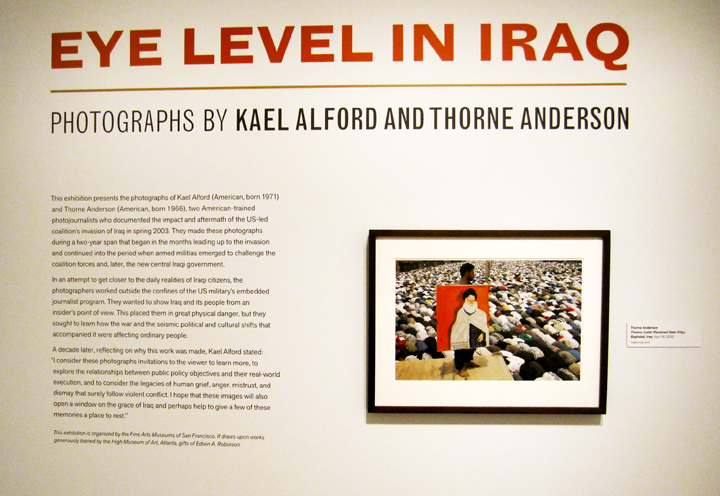 There is an important exhibit at the de Young museum in San Francisco right now that every American should see, must see: Eye Level In Iraq.
There is an important exhibit at the de Young museum in San Francisco right now that every American should see, must see: Eye Level In Iraq.
It presents the photographs and commentary of Kael Alford, and Thorne Anderson, two American-trained photojournalists who documented the impact and aftermath of the US-led coalition’s invasion of Iraq in the Spring of 2003.
They made these photographs during a two-year span that began in the months leading up to the invasion and continued into the period when armed militias emerged to challenge the coalition forces and, later, the new central Iraqi government.
The full exhibit contains 50 or so images. These images and more are included in their book “Unembedded: Four Independent Photojournalists on the War in Iraq.”
Even though I knew that what we see in the American press has been sanitized – one has to read European papers to get a more complete story – I was deeply moved by the photographs – both the people in them and the courage and heart of the photo-journalists to go to these dangerous places and take them. I hope everyone sees them and reflects on what a war truly is – on the ground, for invaded and invader.
Photojournalism like Eye Level In Iraq helps us enormously. It’s not easy or simple or pretty. But if you’re an American, you need to see the whole story. I hope you get to.
PS: If you can’t make it to San Francisco, at least take a look at Kael Alford’s narrated multi-media presentation: Windows On Iraq.
PPS: When we invaded Iraq in 2003, the general political time frame of the war given at the time was that Americans would be on the ground in Iraq for weeks or a few months. My prediction at the time was that Americans would be at war with Iraqis for at least 10 years, and that it would be 70 years or so (that is, 2073) before Iraqis would recover. In other words, they would essentially lose several generations to the effects and trauma of this war. These were among the reasons why I and so many others worldwide protested against the US-led invasion of Iraq in late 2002 and early 2003.
The more I learn and read about our own civil war and how long emancipation has taken to truly be enacted, I am now revising my estimate of how long it will take Iraq to recover from the horror and immense suffering they have had to go through. More likely it will be 150-160 years from now. That is, the year 2163 or thereabouts. Will we be there helping the Iraqi society recover for that long? Somehow I doubt it. Careful planning and funding of every phase – including reconstruction — was notably, shockingly, absent in the US-led coalition’s war in Iraq. (A good overview of this is presented in Fiasco: The American Military Adventure in Iraq, 2003 to 2005 by Thomas E. Ricks).
Why is it important to make predictions? I feel it is the duty of every citizen to learn, read, educate oneself, make an educated guess, and communicate that respectfully in a public forum. As time goes by, you evaluate the results and update your base of knowledge accordingly. As one gets older, one hopefully gets wiser.
Our current society skews heavily towards a warrior culture. The drums of war begin to beat and a glorious vision is painted. The truth and reality is far different and far more complicated. Our society needs far more people who will pause to reflect and consider the long term consequences, who have studied history and are committed to not repeating our mistakes.

No comments yet.